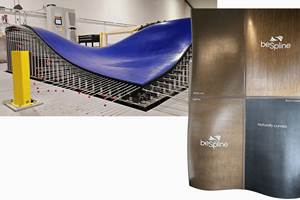Sustainable Marine carbon fiber tidal turbine rotors pass accelerated lifetime testing
Rigorous testing performed at the National University of Ireland, Galway successfully subjected the 4-meter blades to conditions equivalent to 20 years of operation in the field.

Photo Credit: Sustainable Marine
Joining forces with the MaREI Centre at the National University of Ireland, Galway (NUI Galway), through engineering partner Schottel Hydro (Germany), (Nova Scotia, Canada) reports that its new carbon fiber tidal turbine rotors have proven they can survive for two decades in the field. Rigorous testing was performed at the Ryan Institute and School of Engineering at the National University of Ireland Galway, a marine energy center which is said to house a 375-square-meter structures research laboratory. The project was delivered under the Marinet2, a Horizon 2020 program supporting offshore renewable energy testing across the European Union (EU).
Sustainable Marine’s novel floating tidal energy system reportedly uses a common drive train and two different rotor diameters, measuring 6.3 meters and 4 meters, to suit requirements at different resource sites. According to the company, the turbine design consists of a fixed pitch rotor engineered from carbon fiber to enable flex and pitch in overload conditions. This ‘passive-adaptive’ quality, says Sustainable Marine, helps reduce structural loads on the turbines so that smaller, more cost-effective components can be used.
Sustainable Marine is currently preparing to deliver what is says is the world’s first floating tidal energy array in the Bay of Fundy, Nova Scotia.
Having completed extensive tests on the 6.3-meter rotors at NUI Galway, the company returned to the Irish facility to assess the performance of its shorter 4-meter rotors, specifically designed for stronger resource sites. Importantly, the state-of-the-art laboratory carried out ‘accelerated lifetime testing,’ subjecting the rotors to conditions equivalent to 20 years of operation in the field, in just a matter of weeks. It covered a broad range of parameters including stress, strain and vibration.
“We were delighted to return to NUI Galway to extend our partnership with this world-class test and research facility,” says Ralf Starzmann, vice president of business development at Sustainable Marine. “This international collaboration, through our German engineering partner Schottel Hydro, provides a firm indication of our ambitions to continue raising the bar and advance the field of tidal turbine technology. In order to push the boundaries, it is essential that we challenge our solutions at leading facilities that can push the limits of our technology.”
According to Starzmann, accelerated lifetime testing is an essential process which allows Sustainable Marine to rapidly speed up normal conditions, to better understand how structures will react over time. “Our new 4-meter rotor blade has proven to be ‘ultra-durable,” he says, “providing full confidence in the design and structural integrity. Reliability is a key factor in tidal turbine development, particularly as we are now moving towards our first commercial projects.”
The complete analysis in the MaREI Centre at NUI Galway tested rotor behavior under fatigue loading, reviewing aspects such as torsional deflection and overall structural performance. Further in-house testing carried out by Schottel Hydro involved ultimate loading and testing the integrity of the blade until failure.
Sustainable Marine is currently preparing to deliver what is says is the world’s first floating tidal energy array in the Bay of Fundy, Nova Scotia. Earlier this year, it launched its new 420-kilowatt PLAT-I 6.40 floating tidal energy platform, featuring the new 4-meter composite rotors, which is now undergoing commissioning and testing in Grand Passage.
Prof Jamie Goggins, director of research and innovation, at NUI Galway’s School of Engineering, adds: “Due to the nature of shorter blades with significantly higher loads, compared to wind blades, a specialist structural testing facility for tidal turbine blades was required to support the tidal energy industry. We are fortunate to have had great investment from the European Commission, through Horizon 2020, and the Irish Government, through Science Foundation Ireland [SFI] and Sustainable Energy Authority of Ireland [SEAI], to support us in developing our world-leading tidal turbine blade test facility.”
In addition to derisking Sustainable Marine’s full-scale blades, Goggins also notes that this project will help the marine sector reach commercial viability, and aid in training the next generation of energy engineers. “To date, over 100 engineers have worked within our group, as either staff or students, and have gone on to work with some of the world’s leading companies,” he concludes.
Related Content
Plant tour: BeSpline/Addcomp, Sherbrooke, QC, Canada
Composites automation specialist increases access to next-gen technologies, including novel AFP systems and unique 3D parts using adaptive molds.
Read MoreU.S. Coast Guard MBI releases report on Titan submersible
The two-year investigation into the June 2023 tragedy that took five lives has been published, citing key findings, contributing factors to the casualty and a recommended regulatory framework to avoid future oversight.
Read MoreRevisiting the OceanGate Titan disaster
A year has passed since the tragic loss of the Titan submersible that claimed the lives of five people. What lessons have been learned from the disaster?
Read MoreHybrid composite architecture enables rigid wind propulsion solution for maritime decarbonization
GT Wings’ AirWing leverages aerospace engineering principles combined with hybrid glass and carbon fiber composite construction to deliver up to 30% fuel savings through compact, deck-compatible wind propulsion.
Read MoreRead Next
AC Marine & Composites to build composite blades for 2-MW tidal turbine
The 2-megawatt tidal turbine will feature four 10-meter composite blades, and is expected to be the most powerful tidal turbine to date.
Read MoreScaling up, optimizing the flax fiber composite camper
Greenlander’s Sherpa RV cab, which is largely constructed from flax fiber/bio-epoxy sandwich panels, nears commercial production readiness and next-generation scale-up.
Read MoreNext-gen fan blades: Hybrid twin RTM, printed sensors, laser shock disassembly
MORPHO project demonstrates blade with 20% faster RTM cure cycle, uses AI-based monitoring for improved maintenance/life cycle management and proves laser shock disassembly for recycling.
Read More












